Physical Address
304 North Cardinal St.
Dorchester Center, MA 02124
Deep phenotyping is essential to classify pediatric corneal opacities to allow for appropriate management algorithm.
A new classification of neonatal and congenital corneal opacification may help with surgical planning and intervention.
Management options include control of ocular comorbidities (e.g., glaucoma) and systemic comorbidities (e.g., renal or cardiac disease).
Management includes penetrating keratoplasty (PKP), deep anterior lamellar keratoplasty (DALK), automated lamellar keratoplasty (ALK), endothelial keratoplasty (EK), selective endothelial removal, and optical iridectomy, sectoral or nonsectoral.
In PKP and DALK, sutures must be removed early in children to prevent epithelial graft rejection.
Even when a child presents late with bilateral and dense corneal opacification, surgical treatment should not be withheld purely on the grounds of irreversible amblyopia.
Severe visual impairment has a profound effect on global development in an infant and toddler. Therefore even if keratoplasty fails after 12–18 months, the gain in global development should justify the intervention.
Visual function (e.g., contrast sensitivity functions, visual field, and temporal-spatial coordination) is more important than central visual acuity.
Pediatric corneal transplantation has evolved as our understanding of the pathologies that necessitate intervention has changed and, as a consequence, pediatric cases demand a much more integrated approach between pediatric ophthalmologists, cornea specialists, and pediatricians. Not only is knowledge of amblyopia crucial in the management of children with corneal diseases, but an understanding of neurophysiologic mechanisms, such as extended neural plasticity, , and unique ocular phenomena, such as emmetropization, is also vital.
The choices for pediatric keratoplasty have increased dramatically and include penetrating keratoplasty (PKP), deep anterior lamellar keratoplasty (DALK), automated lamellar keratoplasty (ALK), and endothelial keratoplasty (EK). Additionally, selective endothelial removal and optical iridectomy are options that should not be overlooked. Extensive work by developmental pediatricians has demonstrated that severe visual impairment has a profound effect on the global development of an infant or toddler. This research highlights the influence we can have on ocular growth, neural plasticity, the nonvisual cerebral cortex, and even resultant behavior. Essentially, when we measure success of corneal transplantation in children, especially infants, it must reflect global function and not just central visual acuity. In this chapter, we will discuss preoperative assessment, perioperative and operative technique, and postoperative management, among other important concepts directly germane to pediatric keratoplasty.
Pediatric keratoplasty is extremely challenging, and moreso the younger the child is. Issues of cooperation, eye rubbing postsurgery, peculiarities of the tissue of infant eyes preoperatively, tissue reactivity, the aggressive healing response postoperatively, and the intense follow-up postoperatively to prevent complications are all well documented. The burden of pediatric keratoplasty on families adds to these issues and, in turn, results in many adult cornea specialists shying away from treating pediatric corneal diseases requiring keratoplasty.
It is impossible to get a perfect and complete examination every time on a child under the age of 4 years; it is important to identify ancillary signs and symptoms that may indicate potential problems. For example, photophobia may indicate early keratitis or glaucoma; tearing may be due to epithelial defect or glaucoma; a swollen upper lid may indicate a broken or loose suture. Patching a child is not easy, and it is important to consider other approaches such as atropine penalization, and also to recognize when a child has latent nystagmus on top of a manifest nystagmus. Refraction, amblyopia management, and appropriate and timely use of contact lenses are more important in children than realized.
Amblyopia has an effect on more than just the visual cortex. Evidence shows that there is also an effect on the dorsal pathways, including the cerebellum. Speculation exists that stimulus deprivation amblyopia has an even greater effect on nonvisual cortex. Despite dogma suggesting that stimulus deprivation amblyopia in infancy, especially the critical period, cannot be reversed, recent work has proved this to be incorrect in children with bilateral dense congenital cataracts who were operated late in India. The implication is that even when a child presents late with bilateral dense corneal opacification, surgical treatment should not be withheld purely on grounds of irreversible amblyopia. Perhaps, more importantly, this also gives license to consider delaying surgery in bilateral corneal opacities until the child is 4 or 5 months old at the latest. This gain in surgical ease of the operation (slightly larger eye, slightly less elasticity of tissues) means that often the anatomic results are improved (e.g., fewer postoperative iridocorneal adhesions, fewer peripheral anterior synechiae).
Severe visual impairment has a profound effect on the global development of an infant or toddler. Therefore even if keratoplasty fails after 12–18 months, the gain in global development should justify the intervention. Even small improvements in vision can have a profound positive effect on global development. Stulting et al. noted a marked improvement in behavior, communication, and ambulation in many of the children who had undergone PKP even with visual acuity of less than 20/200.
Emmetropization is an active control process of growth of the eye that is influenced by environmental and genetic factors. It is most active in the first 18 months of life followed by 2 further growth phases, to 8 years and then to 16 years of life. The sensory arm of this process likely resides in the retinal amacrine cells with the putative motor arm being the matrix metalloproteinase at the limbus. This is important to know because while, intuitively, central foveal stimulation is important for visual acuity, it is less important to drive normal emmetropization. Using any device that puts the peripheral retina in low contrast , in the first 18 months of life may potentially drive axial growth, causing profound axial myopia in the absence of glaucoma. An obvious example is the Boston keratoprosthesis (KPro), the role of which in pediatric keratoplasty will be discussed later.
Important factors that should be assessed at the initial evaluation are:
etiology including pregnancy, birth, and family history
whether unilateral or bilateral
extent of anterior segment involvement
state of the posterior segment
systemic status of the child, including the developmental state
visual function state
social circumstances of the child.
Is the opacity acquired or congenital (developmental)? To this end, consideration of a classification that helps not only with the organization of thoughts, but also with prognosis has been proposed ( Fig. 124.1 ). This classification allows phenotyping, which ultimately helps the ophthalmologist and the parents to make better informed decisions. A maternal history of infections or medications should be sought together with the birth history, including birth trauma, the use of forceps, gestational age and weight, and any history of retinopathy of prematurity. It is important to note that after forceps injury extensive detachment of the Descemet membrane (DM) can be seen and may need intervention. Any developmental delay or family history of corneal dystrophies or genetic disorders should also be recorded.

Is the condition bilateral or unilateral? Most acquired causes (through infection or trauma) are likely to be unilateral, and most developmental anomalies are likely to be bilateral, although not always. In cases of unilateral congenital corneal opacities, the most important question is whether the better eye is entirely normal or not. Fig. 124.2 shows a child with a dense corneal opacity in one eye and a milder one in the other eye, with iris coloboma and retino-choroidal coloboma. The better eye has a higher risk of developing complications such as a cataract and retinal detachment. Under these circumstances, the threshold for offering penetrating keratoplasty (PK) in the worse affected eye would be much lower. In general, unilateral acquired opacities have a better prognosis than unilateral congenital opacities and PKP may be more rewarding in the setting of acquired, unilateral trauma. The risk of loss of the normal eye to injury should be considered, however; the risks of PKP in an infant may be justified to achieve the benefit of a “spare” eye with ambulatory vision.
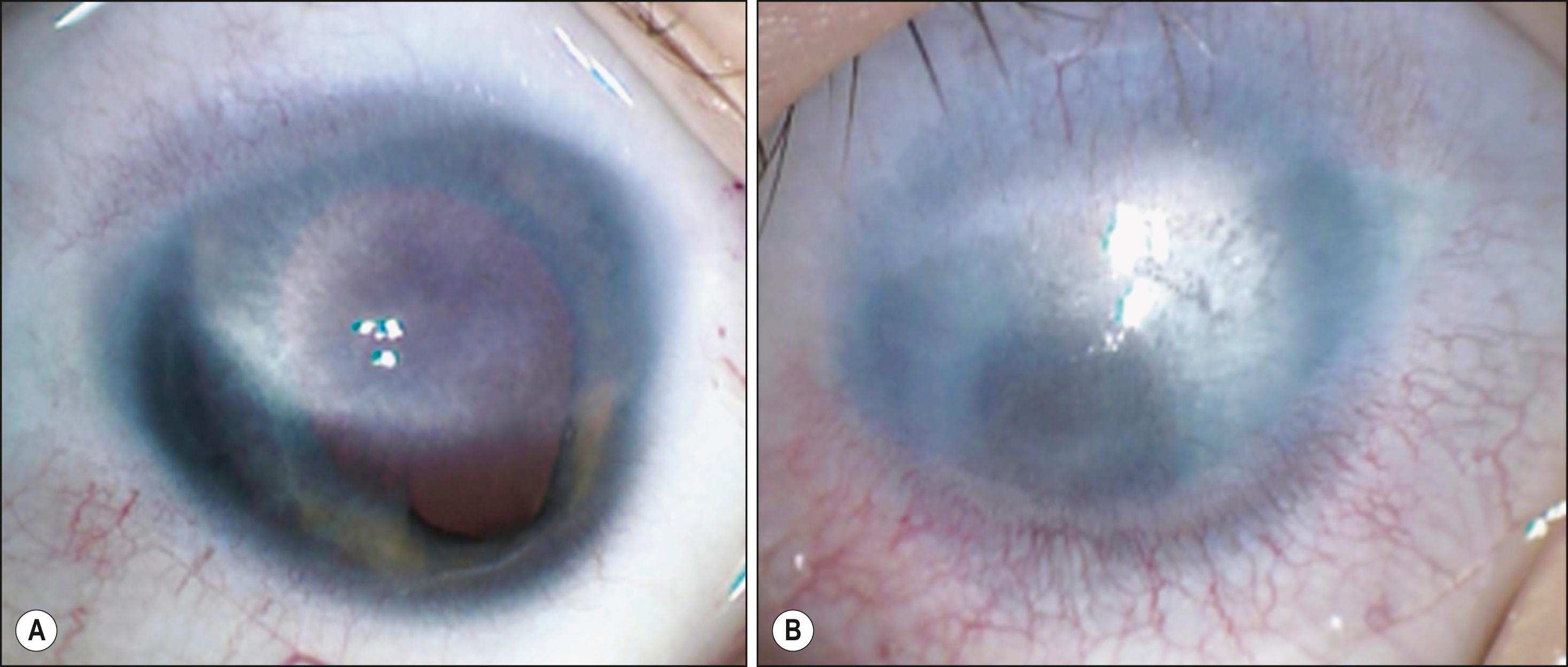
In bilateral cases, surgical intervention is more beneficial since there is evidence that the plasticity is extended in cases of bilateral visual deprivation. Age of presentation in bilateral dense opacities present from birth should not be the driving factor in the decision-making algorithm.
Traditionally, it has been recommended that patients with bilateral, congenital corneal opacities should undergo corneal transplantation within the first 3 months of life, and even as early as 2 weeks to minimize amblyopia. More recently, data from Yang et al. indicate that early surgery does not improve the visual prognosis of PKP for congenital anomalies. Consideration should be given to performing transplantation on the second eye 4–6 weeks after the first to begin prompt visual rehabilitation and to limit the number of postoperative visits.
“Saving” one eye for surgery later ensures that visual acuity will be severely limited by dense amblyopia. Furthermore, operating on both eyes is important, because if one graft fails, useful vision in the other eye will permit continued psychosocial development. It is worth noting that surgery is usually not indicated if the second cornea in bilateral disease has only mild opacification.
How much disruption of the anterior segment and/or posterior segment is there? This can only be assessed with appropriate anterior segment imaging and posterior segment ultrasound together with an electrophysiologic evaluation. Clinicians may not have access to high frequency ultrasound or anterior segment ocular coherence tomography, but this does not mean that the anterior segment cannot be visualized. The clinician can either use a traditional vector probe with a water bath or a linear ultrasound probe. The latter is often used by anesthesiology departments to find venous access. A 10–15 MHz probe can be safely used through closed lids to image the anterior chamber ( Fig. 124.3 ). If there is a marked anatomic disruption, keratoplasty needs to be considered very carefully, since the prognosis may be adversely affected significantly ( Fig. 124.4 ).
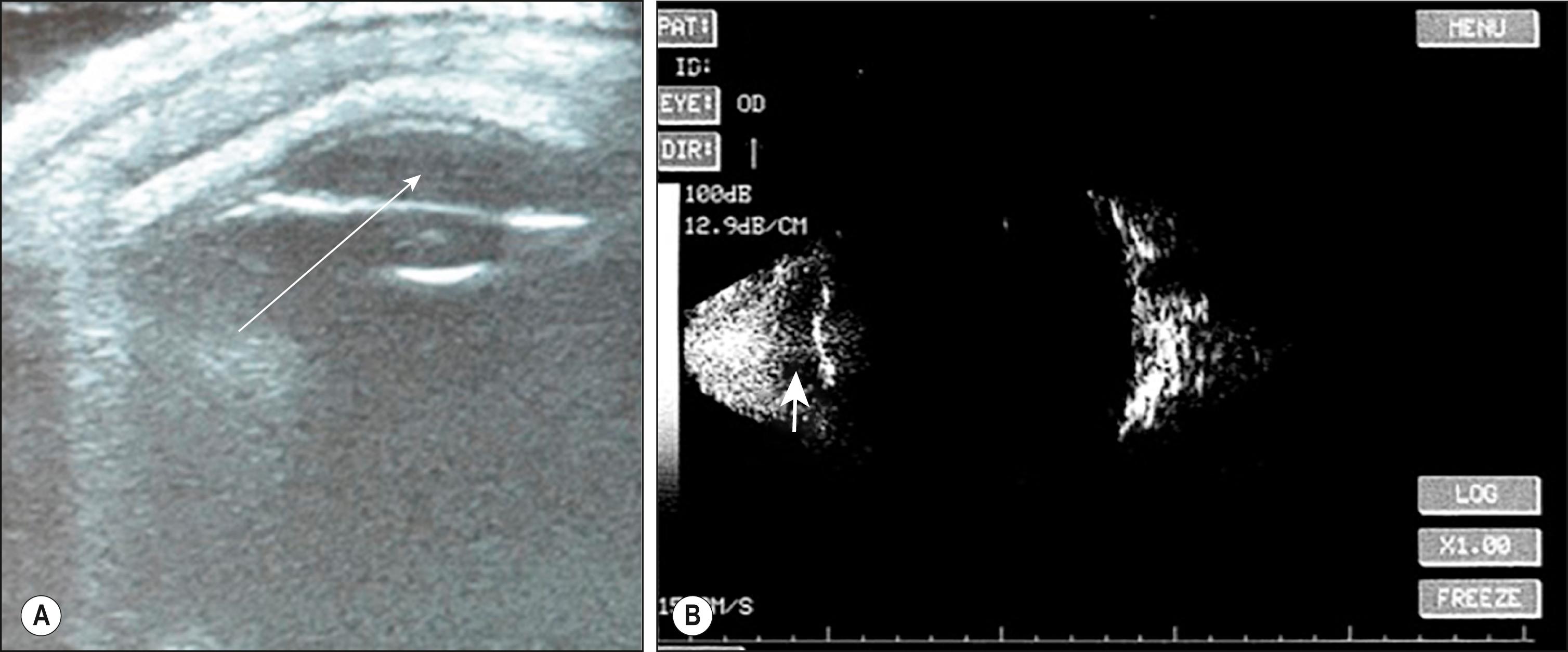
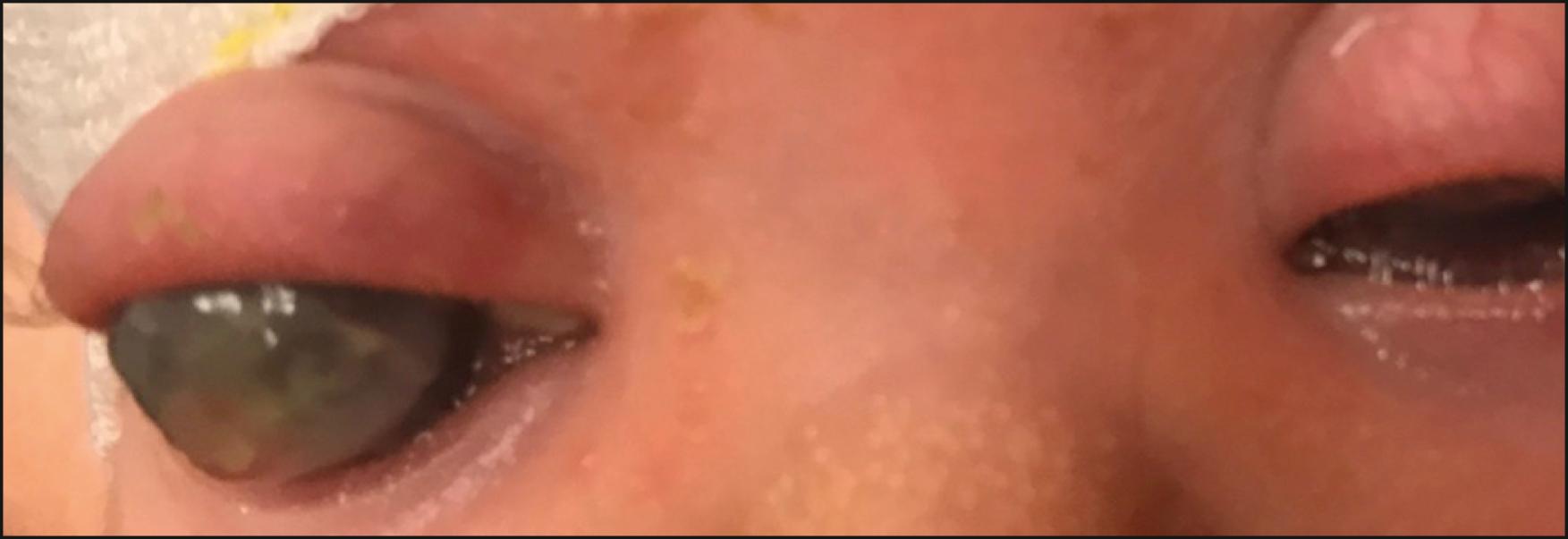
What is the systemic status of the child? Questioning the parents about systemic anomalies or abnormalities is essential. In cases of trauma or infection, the child is usually older, and parents should be aware of any issues. In developmental cases or metabolic disorders, it becomes important to evaluate or to have the child evaluated appropriately. This usually involves a genetic evaluation as well as a systemic pediatric examination. This is much more important in developmental cases than in cases of acquired abnormalities, but is nevertheless important in acquired cases such as those due to metabolic disease such as mucopolysaccharidosis (MPS). Its importance is in excluding life-threatening involvement of critical organ systems (heart, brain, kidneys, and liver). A worthwhile adage is that if there is a developmental anomaly of the eye, there is a higher chance that there will be one of another organ system also. The presence of any developmental delay is important to note, since this may make postoperative evaluation very difficult. In cases of metabolic disorders such as MPS, the timing of systemic therapy is important, since it may affect the procedure one chooses or the longevity of any surgical success. The best example is in the management of corneal clouding secondary to MPS, where bone marrow transplant or enzyme replacement therapy has an ameliorating effect on any mild corneal clouding and certainly reduces clouding of any corneal transplants.
One goal of the initial examination is to measure the preoperative visual acuity. In children under 1 month of age, this may simply entail blinking in response to light, or determination of the presence of a relative afferent pupillary defect. Nonverbal children can be assessed using a central, steady, maintained method: by evaluating fixation; by visual evoked potentials (VEPs); or by preferential looking tests. Flash VEP can be especially helpful because an abnormal flash VEP suggests a marked deficit in the integrity of the visual pathway with a reduced prognosis. For children between 2 and 5 years of age, Allen cards, HOTV matching, or the tumbling E chart can be used. A Snellen acuity or logMAR acuity can usually be obtained from older, verbal children. The presence of any nystagmus should also be noted because this may be an indicator for poor visual potential.
Family support and socioeconomic status may have significant bearing on the success of a pediatric graft. The following questions become important: How will the patient get to and from the doctor for frequent postoperative visits? Who will be able to accompany the child? Can that person take time away from work? Will the family be able to shoulder the financial burden? Who will be able to give the child his or her eye drops? If there is a single parent family, where there are already two or more siblings, the single parent will not likely be able to care for the child about to undergo PK unless the surrounding family/friend support network is extraordinary, especially if that child is an infant. If a two-parent family has more than five children, the commitment needed for a child undergoing PK must be highlighted specifically and explicitly to the parents. The commitment of the child’s family is essential for successful visual rehabilitation.
At the end of the initial evaluation, the ophthalmologist should, therefore, have an idea whether surgical intervention is viable and needs to be sure, if it is warranted, what technique is required depending on the indications.
Children with significant unilateral or bilateral corneal opacities that prevent normal visual function in one or both eyes should be considered candidates for PKP. A traditional classification of the indications for PKP in children uses three groups: congenital, acquired nontraumatic, and acquired traumatic. The congenital group consisted of patients with Peters anomaly, glaucoma with corneal edema, posterior polymorphous dystrophy (PPMD), multiple anterior segment anomalies, and sclerocornea. The acquired nontraumatic group referred to patients with herpes simplex keratitis, bacterial keratitis, Stevens-Johnson syndrome, keratoconus, neurotrophic keratitis, interstitial keratitis, fungal keratitis, and exposure keratopathy. The acquired traumatic patients had sustained corneal or corneoscleral laceration, corneal bloodstaining, or a nonpenetrating corneal injury with scar. The problem is that the terms “Peters anomaly” and “sclerocornea” are, at best, confusing and, at worst, misleading for both parents and surgeons. ,
Sclerocornea, when used in such classifications, alludes to total corneal opacity, which is often secondary to some type of lens pathology or other anterior segment disorder resulting in a totally opaque cornea. , , As a consequence, reviews evaluating the indications for pediatric keratoplasty are hampered because as broad descriptive groups they are useful but not as deep phenotypic groups.
Before 1997, among 400 grafts described in four series, , , , 55% of pediatric eyes had PKs for congenital opacities and 45% had acquired opacities. Between 1997 and 2014, studies reporting results for more than 20 pediatric PKs in which the authors used a congenital or acquired classification scheme showed that 54% (631/1164) of PKs were performed for congenital opacities and 45% (524/1164) for acquired opacities. , , In the last edition of this chapter, the breakdown was 63% congenital and 37% acquired. The reason for this change is best explained by an increased number of reports in the past 5 years of selective keratoplasty (DALK and EK), with more of the congenital corneal opacities (congenital hereditary endothelial dystrophy [CHED], especially) being operated upon using Descemet stripping endothelial keratoplasty (DSEK). Until the end of 2014, 91 DSEKs had been reported on 78 pediatric patients. Indications included corneal dystrophy (61 eyes/40 patients), failed PK (11 eyes/11 patients), post-cataract surgery corneal edema (6 eyes/6 patients), Peters anomaly (2 eyes/2 patients), Descemet breaks after forceps injury (1 eye/1 patient), and bee sting injury (1 eye/1 patient). Using the classification of congenital vs. acquired, this would be 63 eyes and 19 eyes, respectively. In all of these reports, the recovery was faster with less astigmatism; however, in the study that compared one eye with EK and the other with PK of the same patient, the optical clarity of the eye with EK never reached that of the eye with PK. Where ocular coherence tomography (OCT) was available, one report (of two cases of Peters anomaly) demonstrated an irregular posterior optical zone, which explained the unusual retinoscopic reflex described by the authors. It may be that DSEK for Peters anomaly is inappropriate, given the structural changes seen both at the posterior stroma and anteriorly in the Bowman membrane. Since 2014 there have been no reports of case series of EK in children except for sporadic case reports in unusual etiologies and this is more likely due to the fact that more and more commonly, EK is being offered when appropriate to children. ,
Parameters such as postoperative astigmatism, visual acuity, and higher order aberrations (HOA) have been documented after DSEK in adults, with both the change in configuration of the posterior corneal curvature and the host–donor curvature disparity thought to be the cause of HOA. ,
HOA cannot be corrected with spectacles. Recently, a difference in the HOA patterns between normal and amblyopic eyes has been reported, implicating HOAs as a cause of amblyopia in some patients. The effects of HOA, when dealing with children under the age of 8 years, have not been considered in discussions of the benefits of DSEK vs. PK. Poor visual performance in some patients after DSEK could be attributed to interface irregularity, postoperative stromal haze, induction of HOA, and decreased contrast sensitivity. Evaluation of all these factors is important to understand the optical quality of eyes after DSEK and especially in children of amblyogenic age. These factors are yet to be evaluated in the literature. Nevertheless, DSEK reduces the need for a frequent change of glasses, suture-related complications, infections, graft rejection, and the chance of postoperative wound dehiscence, especially in children who are prone to trauma. However, 20% of pediatric eyes that have undergone DSEK have had graft dislocations, which is best explained by vigorous eye rubbing. ,
It has been suggested that there is progressive endothelial loss 6–12 months after small incision endothelial surgery. This issue has been addressed in very few studies of DSEK in children. The rate of endothelial cell loss reported varies from 8% to 48% in DSEK for children. It is worth noting that the rate of endothelial cell loss has been reported as 59% in infant PKP and the presence of iridocorneal adhesions at the graft host junction significantly increases the risk of endothelial cell loss. All these factors should be considered when advocating or discussing options with parents.
Almost all cases of DALK in children reported in pediatric-specific reports have involved cases from the nontraumatic acquired category with scarring from infectious keratitis and keratoconus, with a number of cases of MPS also being reported.
DALK should be considered for all pathologies that spare the endothelium and DM. The long-term outcomes show a lower rate of rejection than PK in children, , but stromal rejection can still occur owing to interface fluid or air retention. , DALK also affords a degree of protection to children if there is blunt trauma owing to the fact that the intact DM may prevent extrusion of intraocular contents. This is a distinct consideration in children with developmental delay who are often at higher risk of such trauma.
If adequate clinical examination is not possible, a sedated examination or an examination under anesthesia is usually required. However, in the author’s experience, most infants under the age of 16 weeks can be adequately examined using high-frequency ultrasound ( Fig. 124.5 ) or linear ultrasound probes ( Fig. 124.6 ). The parent is asked to withhold food from the child for approximately 2 hours prior to the appointment and then have the mother feed the child just before the examination. Infants below the age of 16 weeks will usually fall asleep, allowing the examiner to complete most exams including gonioscopy and high-frequency ultrasound.
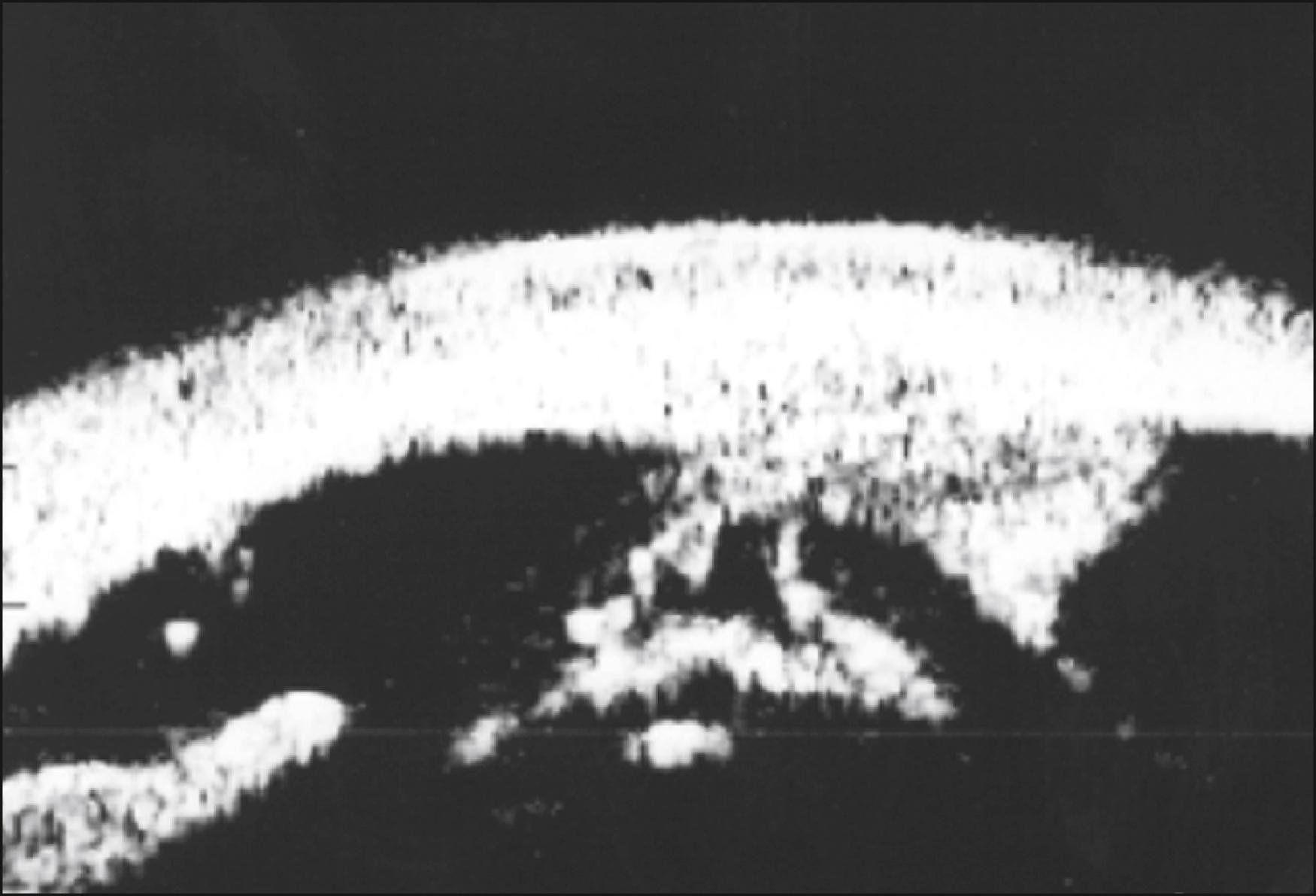
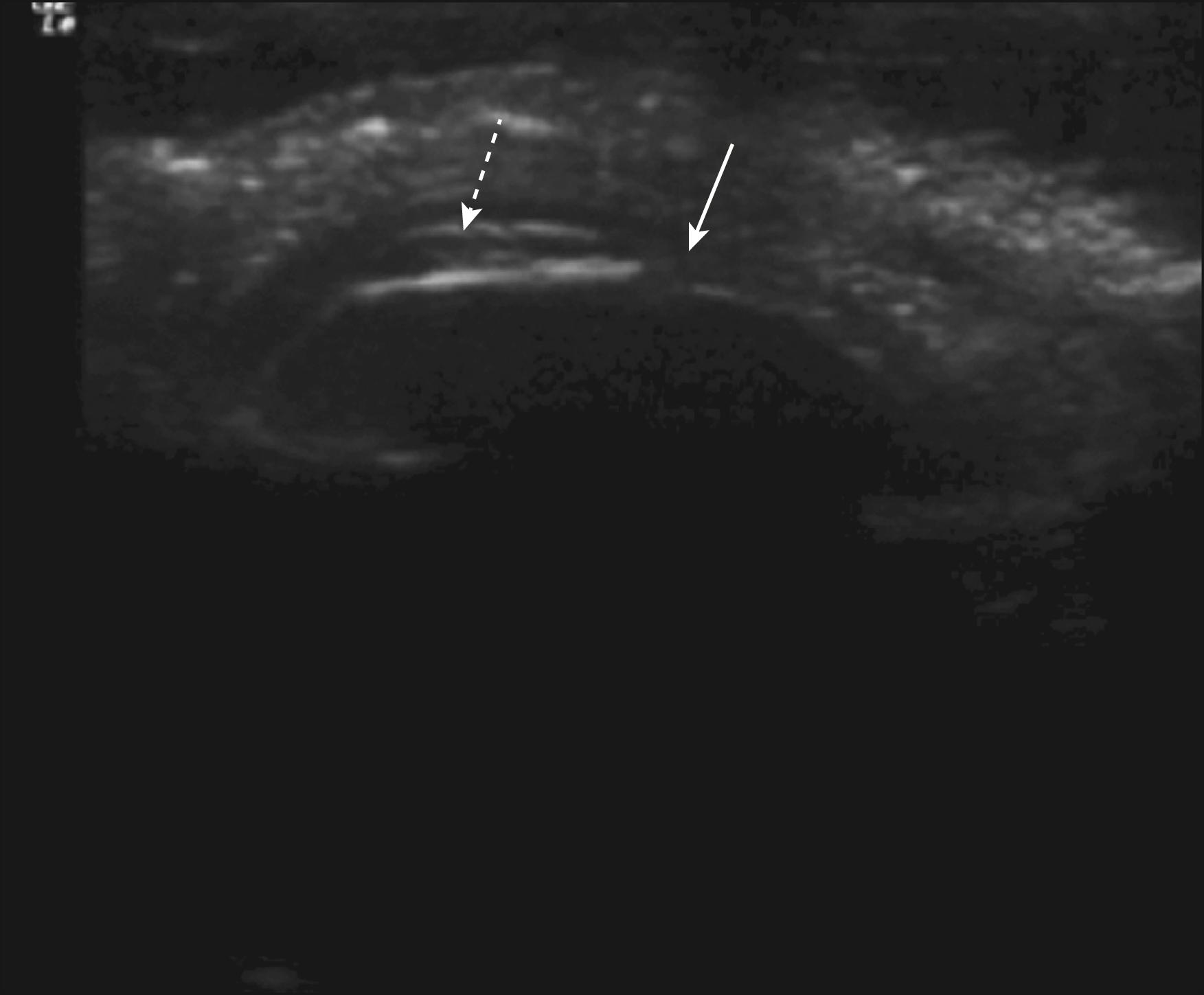
Portable slit lamp examination will permit measurement of the corneal diameter, the degree of corneal opacity, the presence or absence of corneal neovascularization, abnormalities of the iris or angle (by gonioscopy), and any lenticular opacities. These investigations may reveal the coexistence of associated ocular conditions or anomalies that may limit surgical success. The ophthalmologist should also assess eyelid closure, corneal sensation, and tear function. Intraocular pressure (IOP) should be measured with a pneumotonometer or electronic tonometer. Practically, however, digital pressure evaluation is often relied upon. While newer techniques such as the rebound tonometer have made IOP evaluation easier, the current models are unreliable in the presence of a diseased cornea.
Keratometric readings and corneal topography are helpful in some cases of corneal scarring, cornea plana, or keratoconus. Dilated fundoscopy should be performed if possible. B-scan ultrasonography may be helpful in visualizing the posterior segment with denser corneal opacities, and A-scan may be particularly useful in determining the anterior chamber depth and axial length of microphthalmic eyes. Determination of the extent (area) and depth of the opacity and whether the anterior chamber is involved is crucial. If a high-frequency ultrasound is not available, a linear 10–15 MHz-ultrasound probe (see Fig. 124.6 ) can be used with a copious coupling agent through the closed eyelid. An idea of anterior segment involvement can be gained in this manner. Available since June 1997, ultrasound biomicroscopy (UBM) assists with diagnosis as well as with surgical planning for an individual patient. , UBM can locate the pupil when it is not clinically visible, and delineate associated structural abnormalities of the eye, including keratolenticular and iridocorneal adhesions, ectopia lentis, aniridia, and congenital aphakia. It is important to establish the presence or absence of glaucoma early. This is particularly important in traumatic cases where angle damage may predispose the eye to glaucoma if overlooked. A VEP with or without an electroretinogram (ERG) should be performed, especially if there is a view of retina in the periphery that appears to be abnormal.
Parents should be examined, and even mild posterior embryotoxon should be noted, since this may be relevant once molecular diagnosis is known for the child. Ocular colobomas in parents or in parents’ siblings may be relevant, as may early-onset glaucoma. A family pedigree is extremely useful in determining a possible etiology in congenital/developmental cases.
Once this information is gathered, a treatment algorithm ( Fig. 124.7 ) can be used to help determine appropriate therapy. Sometimes, it is appropriate not to intervene surgically even in cases of acquired corneal opacity.

The use of an algorithm for assessment is useful because it helps make a decision about whether intervention is warranted (see Fig. 124.7 ). Once a decision for intervention is made, the surgical choices include:
PKP (including penetrating autokeratoplasty)
EK
DALK
anterior lamellar keratoplasty
selective endothelial removal
optical iridectomy
superficial keratectomy with amniotic membrane transplant
keratoprosthesis.
In this chapter, the techniques for PK, EK, and DALK will be considered in greater detail.
Become a Clinical Tree membership for Full access and enjoy Unlimited articles
If you are a member. Log in here